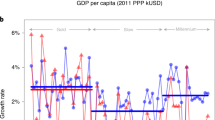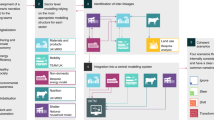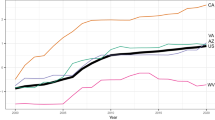Abstract
Ensuring energy security and mitigating climate change are key energy policy priorities. The recent Intergovernmental Panel on Climate Change Working Group III report emphasized that climate policies can deliver energy security as a co-benefit, in large part through reducing energy imports. Using five state-of-the-art global energy-economy models and eight long-term scenarios, we show that although deep cuts in greenhouse gas emissions would reduce energy imports, the reverse is not true: ambitious policies constraining energy imports would have an insignificant impact on climate change. Restricting imports of all fuels would lower twenty-first-century emissions by only 2–15% against the Baseline scenario as compared with a 70% reduction in a 450 stabilization scenario. Restricting only oil imports would have virtually no impact on emissions. The modelled energy independence targets could be achieved at policy costs comparable to those of existing climate pledges but a fraction of the cost of limiting global warming to 2 ∘C.
This is a preview of subscription content, access via your institution
Access options
Subscribe to this journal
Receive 12 digital issues and online access to articles
$119.00 per year
only $9.92 per issue
Buy this article
- Purchase on Springer Link
- Instant access to full article PDF
Prices may be subject to local taxes which are calculated during checkout





Similar content being viewed by others
References
van Renssen, S. Energy security vs climate policy. Nature Clim. Change 4, 756–757 (2014).
European Energy Security Strategy (European Commission, 2014); http://eur-lex.europa.eu/legal-content/EN/TXT/PDF/?uri=CELEX:52014DC0330&from=EN
Rai, S. Narendra Modi roams the world in attempt to secure India’s energy supply. Forbes (25 November 2014); http://www.forbes.com/sites/saritharai/2014/11/25/narendra-modi-roams-the-world-in-attempt-to-secure-indias-energy-supply
Cancun Climate Change Conference (UNFCCC, 2010); http://unfccc.int/meetings/cancun_nov_2010/meeting/6266.php
Intended Nationally Determined Contributions (INDCs) (UNFCCC, 2016); http://www4.unfccc.int/submissions/indc/Submission%20Pages/submissions.aspx
Clarke, L. et al. in Climate Change 2014: Mitigation of Climate Change (eds Edenhofer, O. et al.) 413–510 (IPCC, Cambridge Univ. Press, 2014).
Jewell, J., Cherp, A. & Riahi, K. Energy security under de-carbonization scenarios: an assessment framework and evaluation under different technology and policy choices. Energy Policy 65, 743–760 (2014).
Jewell, J. et al. Energy security of China, India, the E. U. and the U.S. under long-term scenarios. Clim. Change Econ. 4, 1340011 (2013).
Kruyt, B., van Vuuren, D. P., de Vries, H. J. M. & Groenenberg, H. Indicators for energy security. Energy Policy 37, 2166–2181 (2009).
Cherp, A., Jewell, J., Vinichenko, V., Bauer, N. & De Cian, E. Global energy security under different climate policies, GDP growth rates and fossil resource availabilities. Climatic Change 136, 83–94 (2016).
Grubb, M., Butler, L. & Twomey, P. Diversity and security in UK electricity generation: the influence of low-carbon objectives. Energy Policy 34, 4050–4062 (2006).
Shukla, P. R. & Dhar, S. Climate agreements and India: aligning options and opportunities on a new track. Int. Environ. Agreem. 11, 229–243 (2011).
McCollum, D. L., Krey, V. & Riahi, K. An integrated approach to energy sustainability. Nature Clim. Change 1, 428–429 (2011).
Bollen, J., Hers, S. & van der Zwaan, B. An integrated assessment of climate change, air pollution, and energy security policy. Energy Policy 38, 4021–4030 (2010).
McCollum, D. L. et al. Climate policies can help resolve energy security and air pollution challenges. Climatic Change 119, 479–494 (2013).
Cherp, A. & Jewell, J. The concept of energy security: beyond the four As. Energy Policy 75, 415–421 (2014).
Cherp, A. & Jewell, J. The three perspectives on energy security: intellectual history, disciplinary roots and the potential for integration. Curr. Opin. Environ. Sustain. 3, 202–212 (2011).
Sovacool, B. K. & Brown, M. A. Competing dimensions of energy security: an international perspective. Annu. Rev. Environ. Resour. 35, 77–108 (2010).
Farrell, A. E., Zerriffi, H. & Dowlatabadi, H. Energy infrastructure and security. Annu. Rev. Environ. Resourc. 29, 421–469 (2006).
Colglazier, E. W. Jr & Deese, D. A. Energy and security in the 1980s. Annu. Rev. Energy 8, 415–449 (1983).
Yergin, D. Energy security in the 1990s. Foreign Aff. 67, 110–132 (1988).
Stirling, A. Diversity and ignorance in electricity supply investment: addressing the solution rather than the problem. Energy Policy 22, 195–216 (1994).
Cherp, A. et al. Global Energy Assessment: Toward a More Sustainable Future 325–383 (Cambridge Univ. Press, 2012).
Jewell, J. The IEA Model of Short-term Energy Security (MOSES): Primary Energy Sources and Secondary Fuels (OECD/IEA, 2011); http://www.oecd-ilibrary.org/energy/the-iea-model-of-short-term-energy-security-moses_5k9h0wd2ghlv-en
Turton, H. & Barreto, L. Long-term security of energy supply and climate change. Energy Policy 34, 2232–2250 (2006).
Molyneaux, L., Wagner, L., Froome, C. & Foster, J. Resilience and electricity systems a comparative analysis. Energy Policy 47, 188–201 (2012).
Gracceva, F. & Zeniewski, P. A systemic approach to assessing energy security in a low-carbon EU energy system. Appl. Energy 123, 335–348 (2014).
Lubell, H. Security of supply and energy policy in western Europe. World Politics 13, 400–422 (1961).
Calmes, J. & Broder, J. M. Obama sets goal of one-third cut in oil imports. The New York Times (30 March 2011); http://www.nytimes.com/2011/03/31/science/earth/31energy.html?_r=1
Hargreaves, S. Romney sets goal of energy independence by 2020. CNN (23 August 2012); http://money.cnn.com/2012/08/23/news/economy/romney-energy
Das, K. N. Goyal: may stop thermal coal imports in 2–3 years. Reuters India (13 November 2014).
Yergin, D. The Prize: The Epic Quest for Oil, Money, and Power (Simon & Schuster, 1991).
Enerugii kihon keikaku [Basic Energy Plan] (Ministry of Economy, Trade and Industry of Japan, 2010).
Duffield, J. S. & Woodall, B. Japan’s new basic energy plan. Energy Policy 39, 3741–3749 (2011).
Cheon, A. & Urpelainen, J. Escaping oil’s stranglehold: when do states invest in energy security? J. Confl. Resolut. 59, 953–983 (2015).
Industry Division of the Economic Commission for Europe Relationship Between Coal and Black Oils in the West European Fuel Market (United Nations, 1954).
Tavoni, M. Post-2020 climate agreements in the major economies assessed in the light of global models. Nature Clim. Change 5, 119–126 (2015).
Kriegler, E. et al. What does the 2 C target imply for a global climate agreement in 2020? The LIMITS Study on Durban Platform Scenarios. Clim. Change Econ. 4, 1340008 (2013).
McCollum, D., Bauer, N., Calvin, K., Kitous, A. & Riahi, K. Fossil resource and energy security dynamics in conventional and carbon-constrained worlds. Climatic Change 123, 413–426 (2014).
Riahi, K. et al. Locked into Copenhagen pledges—Implications of short-term emission targets for the cost and feasibility of long-term climate goals. Technol. Forecast. Soc. Change 90, 8–23 (2015).
Kriegler, E. et al. Making or breaking climate targets: the AMPERE study on staged accession scenarios for climate policy. Technol. Forecast. Soc. Change 90, 24–44 (2015).
Tavoni, M. et al. The distribution of the major economies’ effort in the Durban platform scenarios. Clim. Change Econ. 4, 1340009 (2013).
Clarke, L. et al. International climate policy architectures: overview of the EMF 22 international scenarios. Energy Econ. 31, S64–S81 (2009).
van Vuuren, D. P. & Carter, T. R. Climate and socio-economic scenarios for climate change research and assessment: reconciling the new with the old. Climatic Change 122, 415–429 (2014).
O’Neill, B. C. et al. A new scenario framework for climate change research: the concept of shared socioeconomic pathways. Climatic Change 122, 387–400 (2013).
SSP Database (Shared Socioeconomic Pathways) - Version 1.0 (2015) https://secure.iiasa.ac.at/web-apps/ene/SspDb
Kriegler, E. et al. Diagnostic indicators for integrated assessment models of climate policy. Technol. Forecast. Soc. Change 90, 45–61 (2014).
van Vuuren, D. P. Energy Systems and Climate Policy-Long-Term Scenarios for an Uncertain Future PhD thesis, Utrecht Univ. (2007).
Integrated Modelling of Global Environmental Change (Netherlands Environmental Assessment Agency (MNP), 2006).
Riahi, K., Grubler, A. & Nakicenovic, N. Scenarios of long-term socio-economic and environmental development under climate stabilization. Technol. Forecast. Soc. Change 74, 887–935 (2007).
Riahi, K. et al. Global Energy Assessment: Toward a More Sustainable Future 1203–1306 (Cambridge Univ. Press, 2012).
Bauer, N. et al. Global fossil energy markets and climate change mitigation—an analysis with REMIND. Climatic Change 136, 69–82 (2016).
Keppo, I. J. & van der Zwaan, B. The impact of uncertainty in climate targets and CO2 storage availability on long-term emissions abatement. Environ. Model Assess. 17, 177–191 (2011).
Kober, T., van der Zwaan, B. & Rösler, H. Emission certificate trade and costs under regional burden-sharing regimes for a 2 ∘C climate change control target. Clim. Change Econ. 5, 1440001 (2014).
Bosetti, V., De Cian, E., Sgobbi, A. & Tavoni, M. The 2008 WITCH Model FEEM Working Paper No. 85.2009 (Fondazione Eni Enrico Mattei, 2009).
Bosetti, V., Carraro, C., Galeotti, M., Massetti, E. & Tavoni, M. WITCH: a world induced technical change hybrid model. Energy J. 27, 13–37 (2006).
Pethig, R. & Wittlich, C. Interaction of Carbon Reduction and Green Energy Promotion in a Small Fossil-fuel Importing Economy (CESIFO, 2009).
Böhringer, C. & Rosendahl, K. E. Green promotes the dirtiest: on the interaction between black and green quotas in energy markets. J. Regul. Econ. 37, 316–325 (2010).
Fankhauser, S., Hepburn, C. & Park, J. Combining multiple policy instruments. Clim. Change Econ. 1, 209–225 (2010).
Government of Japan Submission of Japan’s Intended Nationally Determined Contribution (INDC) (UNFCCC, 2015).
Toichi, T. Energy security in Asia and Japanese policy. CAPR 10, 44–51 (2003).
Calder, K. E. Japan’s energy angst: Asia’s changing energy prospects and the view from Tokyo. Strategic Anal. 32, 123–129 (2008).
World Energy Outlook 2014 (OECD/IEA, 2014).
BP Energy Outlook 2030 (British Petroleum, 2013).
Neff, S. & Coleman, M. EIA outlook: reversal in U.S. oil import dependency. ESR 5, 6–13 (2014).
Scheepers, M., Seebregts, A. J., de Jong, J. & Maters, H. EU Standards for Energy Security of Supply 1–104 (ECN/Clingendael International Energy Programme, 2007).
A Quest for Energy Security in the 21st Century: Resources and Constraints 1–113 (Asia Pacific Energy Research Centre, 2007).
Climate Action Tracker Effect of Current Pledges and Policies on Global Temperature (Ecofys, Climate Analytics, PIK, New Climate Institute, 2015); climateactiontracker.org
Spencer, T. et al. Beyond the Numbers (Institut du développement durable et des relation internationales, 2015).
PBL Climate Pledge INDC Tool (PBL, 2015); http://infographics.pbl.nl/indc
Meinshausen, M. et al. The RCP greenhouse gas concentrations and their extensions from 1765 to 2300. Climatic Change 109, 213–241 (2011).
Rogelj, J., Meinshausen, M. & Knutti, R. Global warming under old and new scenarios using IPCC climate sensitivity range estimates. Nature Clim. Change 2, 248–253 (2012).
O’Neill, B. C. et al. The roads ahead: narratives for shared socioeconomic pathways describing world futures in the 21st century. Glob. Environ. Change http://dx.doi.org/10.1016/j.gloenvcha.2015.01.004 (2015).
Acknowledgements
The research leading to these results has received funding from the European Union Seventh Framework Programme FP7/2007–2013 under grant agreement no. 282846 (LIMITS). A.C. and V.V. also received support from CEU’s Intellectual Themes Initiative. We would also like to thank P. Kolp for technical support.
Author information
Authors and Affiliations
Contributions
J.J., A.C., K.R., D.M. and V.K. designed the experiments. J.J. and V.V. analysed the data. V.V., D.M., N.B., T.A., O.F., M.H., T.K., V.K., G.M., M.T., D.P.v.V. and B.v.d.Z. performed the experiments and contributed tools and analysis methods. J.J. and A.C. wrote the paper with input from all authors.
Corresponding author
Ethics declarations
Competing interests
The authors declare no competing financial interests.
Supplementary information
Supplementary Information
Supplementary Figures 1–13, Supplementary Tables 1–16, Supplementary Notes 1–5, Supplementary References. (PDF 2393 kb)
Rights and permissions
About this article
Cite this article
Jewell, J., Vinichenko, V., McCollum, D. et al. Comparison and interactions between the long-term pursuit of energy independence and climate policies. Nat Energy 1, 16073 (2016). https://doi.org/10.1038/nenergy.2016.73
Received:
Accepted:
Published:
DOI: https://doi.org/10.1038/nenergy.2016.73



